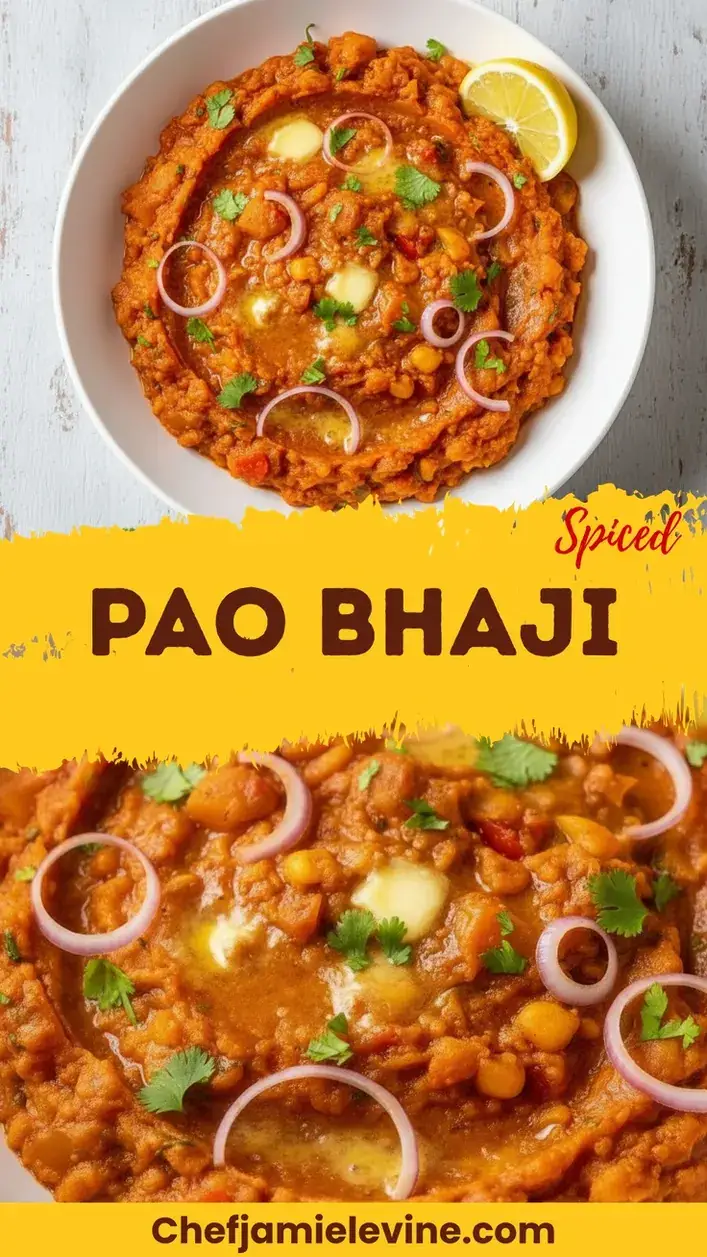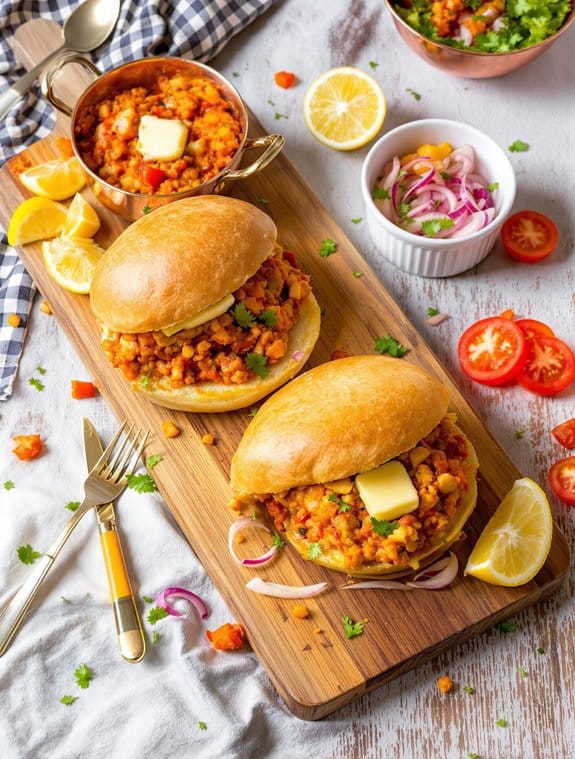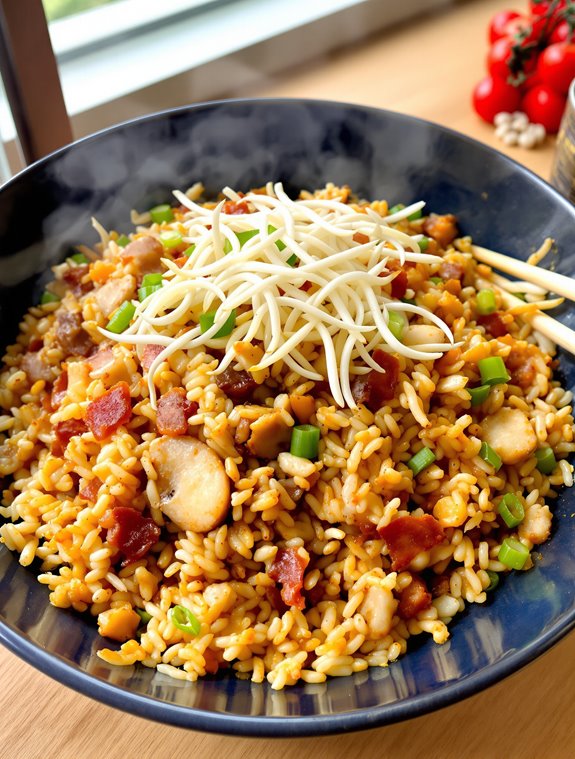Why You’ll Love this Pao Bhaji
What’s not to love about a dish that combines flavorful mashed vegetables with buttery, toasted bread rolls?
This Mumbai street food classic has been my go-to comfort meal for years. The hearty potato-vegetable mixture, spiced with that distinctive pao bhaji masala, creates a symphony of flavors that dance on your tongue.
I adore how versatile it is—perfect for weeknight dinners or casual gatherings.
The contrast between the soft, spicy veggie mash and the crispy, oil-toasted rolls? Simply divine.
And trust me, watching your guests’ faces light up when they take their first bite makes any cooking effort worthwhile.
What Ingredients are in Pao Bhaji?
Pao Bhaji is all about creating that perfect balance of vegetables, spices, and bread. The beauty of this Mumbai street food is how it transforms humble ingredients into something absolutely magnificent. The veggie mixture combines starchy potatoes with colorful cauliflower, carrots, and peas, while the aromatic spices bring everything to life.
Ready to gather what you need for this flavor-packed dish?
- 4 potatoes, peeled and cut
- 1/2 head cauliflower, chopped or grated
- 2 carrots, chopped or grated
- 1 cup green peas
- 1/4 cup channa dal (split chickpeas)
- 2 onions, chopped
- 4 tomatoes, sliced
- 12 bread rolls or buns
- 2 tablespoons oil (plus extra for pan-frying rolls)
- 1 teaspoon salt
- 1 teaspoon mustard seeds
- 2 whole red chilies
- 1/2 teaspoon red chili powder
- 2 teaspoons pao bhaji masala
When shopping for these ingredients, don’t stress if you can’t find channa dal immediately—it’s available at most Indian grocery stores alongside the pao bhaji masala.
The bread rolls are quite important too; traditional pao bhaji uses soft, slightly sweet buns, but any dinner roll will work in a pinch.
And while the recipe calls for specific vegetables, this dish is wonderfully forgiving. Got extra bell peppers or beans? Toss them in. The soul of pao bhaji is adaptability, making it perfect for using whatever’s in your vegetable drawer.
How to Make this Pao Bhaji

Begin this Mumbai street food adventure by getting your vegetables ready. First, wash, peel, and cut 4 potatoes into chunks. Then wash, trim, and chop (or grate) 1/2 head of cauliflower and 2 carrots into small pieces—the smaller the pieces, the quicker they’ll cook and meld together. Rinse 1/4 cup of channa dal and add it to a 2-quart pot with about 2 cups of water, bringing it to a boil.
After the dal has cooked for about 10 minutes, toss in those potato pieces and 1 teaspoon of salt. Let this mixture cook until the potatoes are tender enough to mash, then go ahead and mash them together with the dal. Now’s the time to add your prepped cauliflower, carrots, and 1 cup of green peas to this fragrant base. Cook for another 15 minutes until everything is tender, adding water as needed to maintain a moist consistency.
While your vegetable mixture is simmering away, let’s create that signature spice base. Heat 2 tablespoons of oil in a skillet over medium heat and add 1 teaspoon of mustard seeds—listen for that satisfying pop! Once they’re dancing in the oil, add 2 whole red chilies (you can remove these before serving if you’re spice-shy). Toss in 2 chopped onions and stir until they become translucent and slightly golden.
Now comes the magical merger: add your cooked vegetable mixture to the spiced onions and cook for about 5 minutes. The texture should be moist but not soupy, almost like a thick stew. Finally, stir in 1/2 teaspoon of red chili powder and 2 teaspoons of pao bhaji masala, adjusting to your taste preferences. Remember, the spices are what make this dish sing, so don’t be afraid to taste and tweak.
For the grand finale, we need to prepare those bread rolls. Separate your 12 bread rolls and toast them in a hot skillet with a touch of oil—just enough to give them a golden-brown exterior while keeping the inside soft and pillowy. The contrast between the crispy, buttery roll and the soft, spicy vegetable filling is what makes pao bhaji so irresistible.
To assemble, place a generous spoonful of your vegetable mixture on one half of a toasted roll, top with a slice of fresh tomato from your 4 sliced tomatoes, and crown it with the other half. Serve these bundles of joy hot, perhaps with a squeeze of lemon and a sprinkle of chopped cilantro if you’re feeling fancy. Who knew vegetables could taste this spectacular?
Pao Bhaji Substitutions and Variations
While traditional recipes have their charm, the beauty of pao bhaji lies in its flexibility.
I often swap potatoes with sweet potatoes for a nutritional boost, or cauliflower with broccoli when that’s what’s in my fridge. No pao bhaji masala? Mix garam masala with cumin and coriander powder instead.
For the bread, I’ve used everything from burger buns to ciabatta rolls. Sometimes I skip the bread entirely and serve the bhaji over rice or with tortillas.
Feeling fancy? Add cheese on top or garnish with pomegranate seeds for a sweet-savory twist. Cooking is all about making it your own, isn’t it?
What to Serve with Pao Bhaji
Now that we’ve explored recipe variations, let’s talk about the supporting cast for your pao bhaji masterpiece.
I always serve mine with a side of raw, thinly sliced onions sprinkled with lemon juice and a dollop of cool butter that melts deliciously on top of the hot bhaji.
Want to elevate your meal? Add a revitalizing cucumber raita or kachumber salad to balance the spices.
A tall glass of salted lassi or nimbu pani (Indian lemonade) cuts through the richness perfectly.
Remember those lemon wedges, too—they brighten everything with a squeeze.
Final Thoughts
After making pao bhaji countless times in my kitchen, I’m convinced it’s one of India’s most perfect comfort foods. The vibrant flavors, the contrast of spicy vegetable mash with buttery, toasted rolls—it’s pure Mumbai street food magic in every bite.
What I love most is how forgiving this recipe is. No cauliflower? Use more carrots. Want it spicier? Add another chili.
The heart of pao bhaji is adaptability.

Mumbai Street Food Pao Bhaji
Ingredients
Equipment
Method
- Rinse the channa dal and add to a pot with 2 cups of water. Bring to a boil and cook for about 10 minutes.
- Add the potato chunks and salt to the dal. Cook until potatoes are tender enough to mash.
- Mash the potatoes and dal together to form a smooth base.
- Add the cauliflower, carrots, and green peas to the mashed mixture. Cook for approximately 15 minutes until all vegetables are tender, adding water as needed to maintain moisture.
- Meanwhile, heat oil in a skillet over medium heat. Add mustard seeds and wait for them to pop.
- Add the whole red chilies and chopped onions to the skillet. Sauté until onions become translucent and slightly golden.
- Transfer the cooked vegetable mixture to the skillet with the spiced onions. Cook together for about 5 minutes, ensuring the texture is moist but not soupy.
- Stir in the red chili powder and pao bhaji masala. Adjust seasoning to taste.
- For the bread rolls, heat a separate skillet with a little oil. Split the rolls and toast them until golden-brown on the cut sides.
- To serve, place a generous portion of the vegetable mixture (bhaji) on a plate alongside a toasted roll (pao). Top the bhaji with a slice of fresh tomato if desired.



